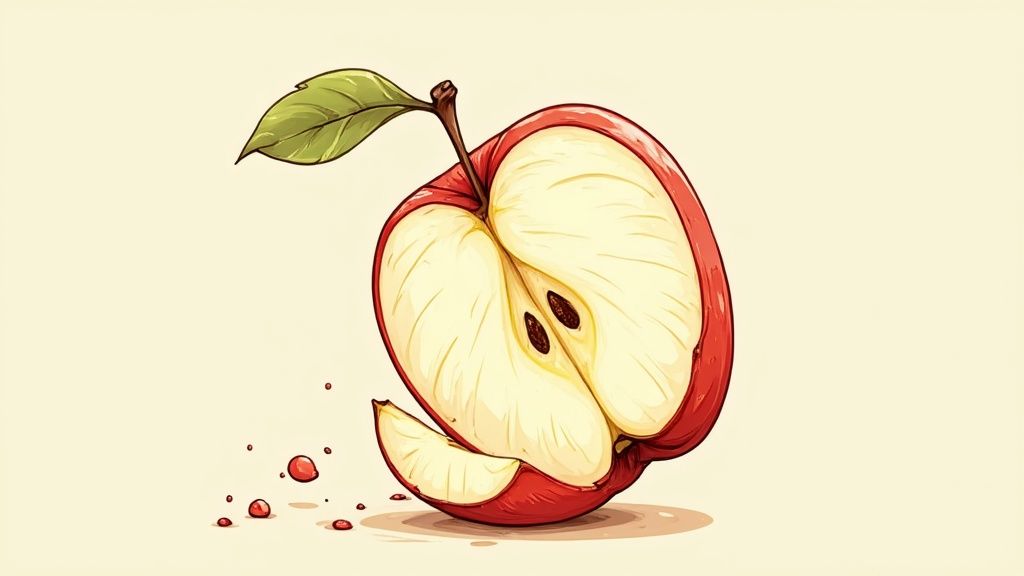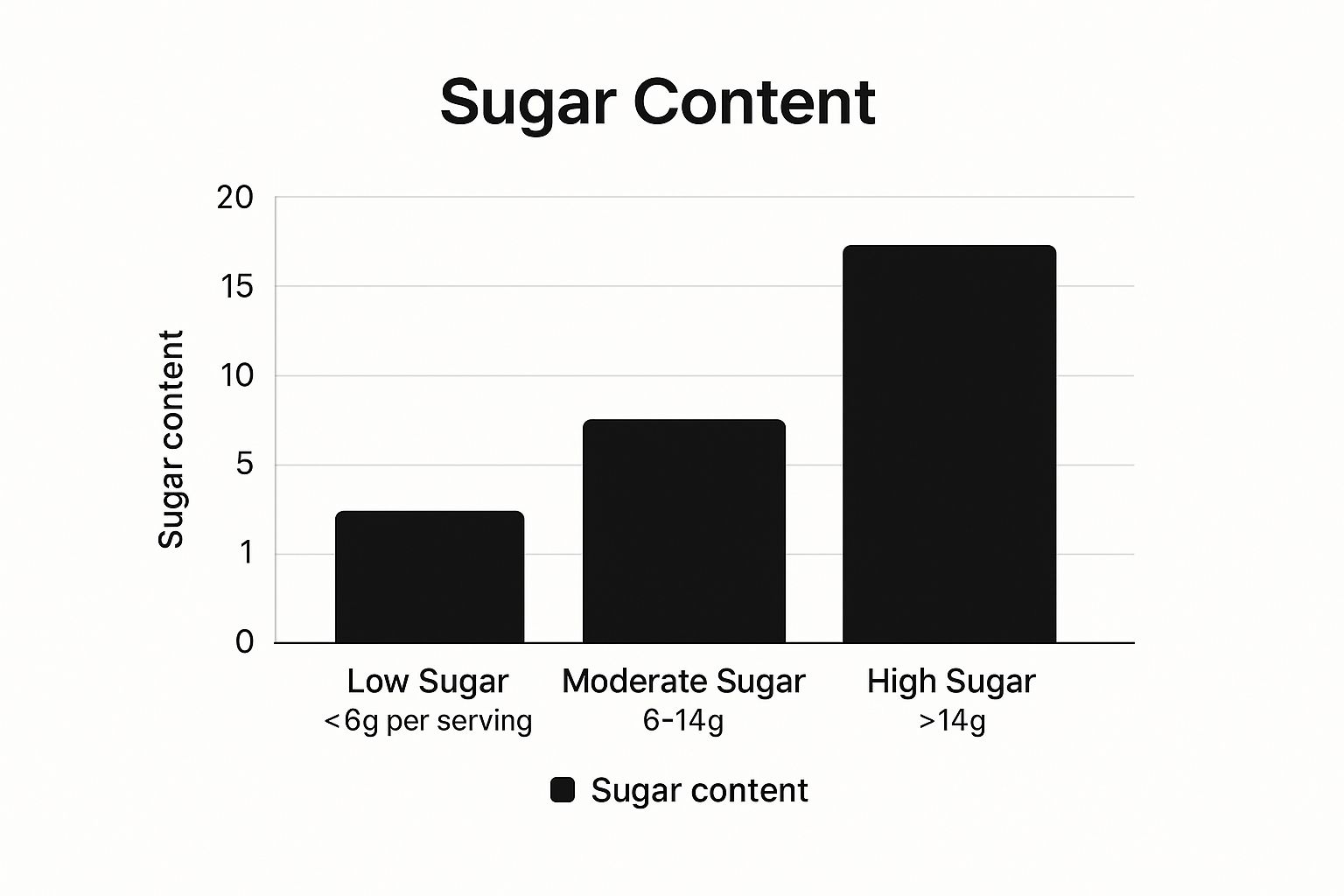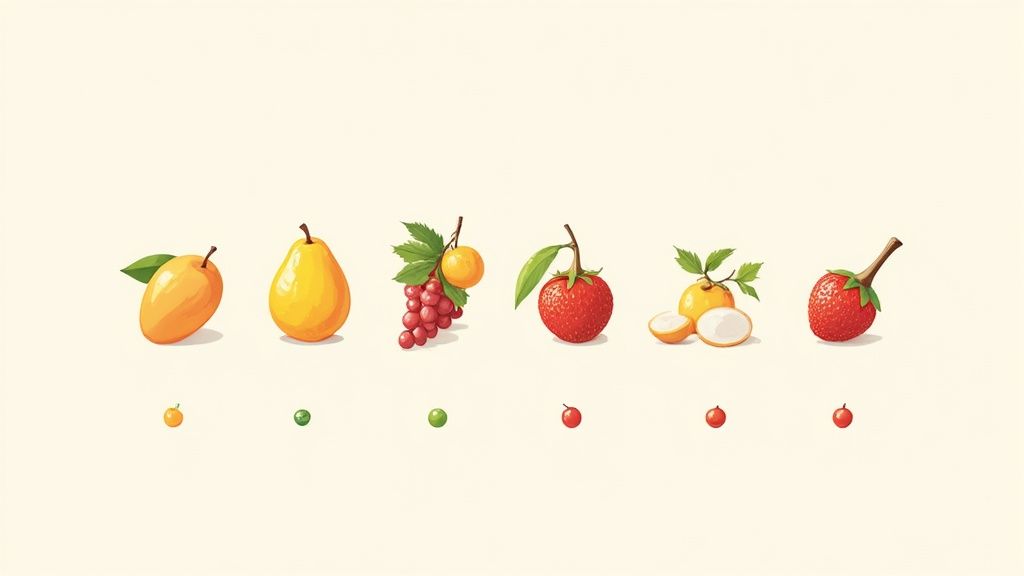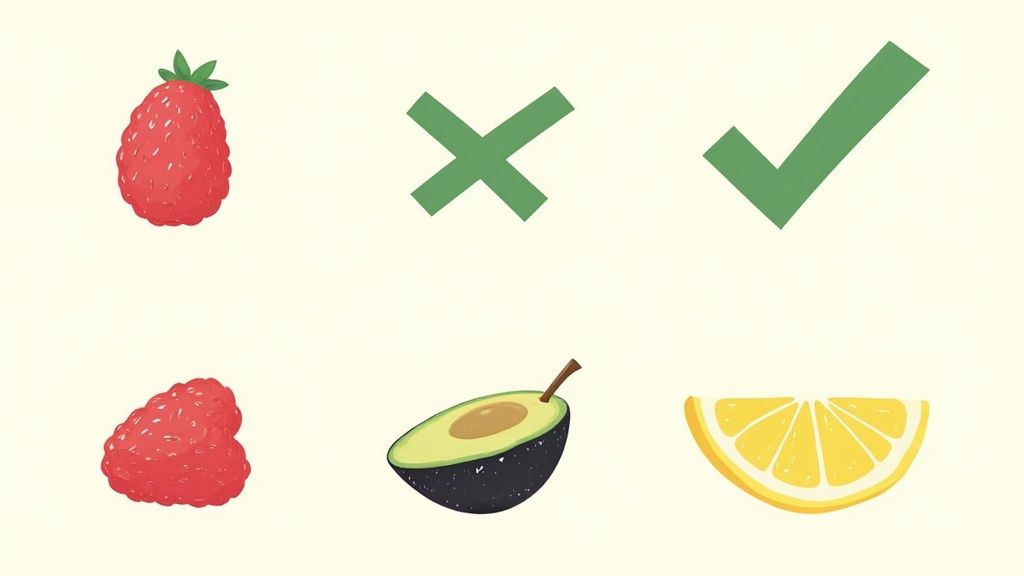Your Guide to the Sugars in Fruits Chart

A sugars in fruits chart is a handy tool for quickly comparing the natural sugar content in your favorite fruits. It can be surprising to see the difference—a cup of sweet mango packs over 20 grams of sugar, while the same amount of tart raspberries has only 5 grams. Knowing where fruits fall on this spectrum is the first step toward making smarter choices for your health.
So, How Does Fruit Sugar Actually Affect Your Body?

When you hear about the problems with sugar, the conversation is almost always about added sugars—the kind you find in candy, soda, and processed foods. The natural sugar in whole fruit is a completely different story.
The sugar in fruit, mostly fructose, doesn't come alone. It’s bundled up with a whole team of nutrients that your body needs, and the most important player here is fiber.
Fiber is a game-changer. It slows everything down, including how quickly your body absorbs sugar. This slow-release process helps you avoid the sharp blood sugar spikes you'd get from a sugary drink. Think about it: the fiber in a whole apple makes its natural sugar much easier for your body to handle than the free-floating sugar in a glass of apple juice.
Why Whole Fruits Always Win
This "package deal" of nutrients is precisely why whole fruit is so good for you. Besides fiber, you're also getting:
- Vitamins and Minerals: These are crucial for just about every function in your body.
- Antioxidants: Powerful compounds that protect your cells from damage and fight inflammation.
- Water: Most fruits are loaded with water, which helps keep you hydrated.
All these elements work together, which helps explain why different fruits can have a different impact on your blood sugar. To really get a handle on this, it's worth understanding what the glycemic index is and how it ranks foods based on their effect on blood sugar. This concept is key to getting the most out of any sugars in fruits chart.
A Quick Guide to Fruit Sugar Levels
Sometimes you just need a straightforward answer without getting lost in the numbers. That's exactly what this section is for—a simple, visual snapshot of where different fruits land on the sugar spectrum.
Think of it as your cheat sheet. Before you dive into the detailed breakdown later on, this chart and table will help you quickly gauge which fruits align best with your health goals.

As you can see, fruits generally fall into one of three buckets: low, moderate, or high in sugar. Understanding these categories is the first step to making more mindful choices about your fruit intake.
Putting This Into Practice
So, how can you use this in your day-to-day life? It's all about making quick, informed decisions without having to pull up a detailed nutritional database every time you eat.
Instead of trying to remember that a cup of raspberries has about 5 grams of sugar, just remember that berries are a fantastic low-sugar option. This makes it easy to decide what to toss into your smoothie or yogurt. On the other hand, knowing that fruits like mangoes are in the high-sugar category serves as a helpful reminder to watch your portion size.
Your Complete Guide to Sugar in Fruit
If you're looking to get specific about the sugar in your diet, you've come to the right place. While a quick overview is helpful, this comprehensive chart breaks down the numbers for over 30 common fruits, so you can see exactly what you're eating.
Think of this as your go-to reference. You can quickly see how 5 grams of sugar in a cup of cranberries compares to the 23 grams you’d get from a cup of mango. Having these details handy makes it much easier to plan your meals and snacks around your personal health goals.
How to Get the Most Out of This Chart
Don't just look at the sugar column—the real magic is in comparing total sugar to fiber. Why? Because fiber is your friend when it comes to sugar. It slows down how quickly your body absorbs the sugar, which helps prevent those sharp spikes and crashes in your blood glucose.
When you're looking at the numbers, keep these points in mind:
- Total Sugar: This is the main number to watch.
- Dietary Fiber: A higher number here is a good thing! It helps balance the sugar.
- Serving Size: We’ve standardized everything to a one-cup serving to make comparing fruits simple.
It's all about finding that balance. You'll notice that some fruits pack a surprising amount of sugar. For instance, lychees can be up to 15% sugar by weight, which adds up to a hefty 29 grams per cup. Pomegranates and mangoes are also on the higher end, hovering around 14%. You can dig deeper into these specifics on MyFoodData.com's high-sugar fruits list.
Ready to dive in? Use the table below to compare your favorites, find lower-sugar alternatives, and make informed choices that work for you.
Comprehensive Fruit Sugar Content (per 1 cup serving)
Here's a detailed breakdown of common fruits, listed from lowest to highest sugar content. This allows for a quick and easy comparison to help you find the best options for your dietary needs.
| Fruit | Serving Size | Total Sugar (grams) | Total Carbohydrates (grams) | Fiber (grams) |
|---|---|---|---|---|
| Cranberries | 1 cup | 5 | 12 | 4 |
| Raspberries | 1 cup | 5 | 15 | 8 |
| Blackberries | 1 cup | 7 | 14 | 8 |
| Strawberries | 1 cup | 7 | 12 | 3 |
| Watermelon | 1 cup | 9 | 11 | 1 |
| Cantaloupe | 1 cup | 12 | 13 | 1 |
| Papaya | 1 cup | 12 | 16 | 3 |
| Honeydew | 1 cup | 14 | 16 | 1 |
| Blueberries | 1 cup | 15 | 21 | 4 |
| Pineapple | 1 cup | 16 | 22 | 2 |
| Oranges | 1 cup | 17 | 21 | 4 |
| Kiwi | 1 cup | 17 | 26 | 5 |
| Pears | 1 cup | 17 | 27 | 6 |
| Peaches | 1 cup | 17 | 19 | 3 |
| Apples | 1 cup | 19 | 25 | 4 |
| Bananas | 1 cup | 20 | 28 | 3 |
| Grapes | 1 cup | 23 | 27 | 1 |
| Mango | 1 cup | 23 | 25 | 3 |
| Pomegranate | 1 cup | 24 | 29 | 7 |
| Cherries | 1 cup | 25 | 32 | 4 |
| Lychee | 1 cup | 29 | 31 | 3 |
| Figs | 1 cup | 29 | 38 | 6 |
| Dates (Medjool) | 1 cup | 93 | 110 | 10 |
As you can see, the sugar content varies wildly from fruit to fruit. Berries tend to be fantastic low-sugar options, while tropical fruits and dried fruits like dates are much more concentrated in sugar. Having this information allows you to be more mindful and strategic with your fruit choices.
Navigating High-Sugar Fruits

While our fruit sugar chart is full of great low-sugar options, it's just as important to know which fruits sit on the other side of the fence. These higher-sugar fruits are by no means "bad" for you. They're just naturally very sweet, which means you might want to eat them a bit more mindfully, especially if you're keeping a close eye on your sugar or calorie intake.
Fruits like mangoes, grapes, lychees, and figs are famous for their candy-like sweetness, and that's because they are packed with natural sugars. This is what makes them so delicious, but it also means they can affect your blood sugar more significantly. Knowing this ahead of time is the key to enjoying them without getting off track.
Understanding the Numbers
Let's put this into perspective. A single, delicious mango can have a whopping 45 to 46 grams of sugar. When you think about recommended daily limits for added sugars, you can see how one fruit could take up a big chunk of that allowance.
Here are a few other popular fruits with higher sugar content:
- Grapes: One cup has around 23 grams of sugar.
- Cherries: A cup of sweet cherries contains about 20 grams of sugar.
- Lychees: This tropical treat packs roughly 29 grams of sugar per cup.
The idea here isn't to cut these fruits out completely, but rather to practice moderation. Once you know the numbers, you can make smarter choices about your portion sizes and still enjoy these sweet treats as part of a healthy, balanced diet.
Knowing which fruits are high in sugar is crucial for anyone managing their blood glucose. Understanding https://stopsugar.app/blog/what-foods-spike-blood-sugar can help you build better meals and snacks. A great trick is to pair a small serving of a high-sugar fruit with some protein or healthy fat, like a handful of nuts or a scoop of plain yogurt. This simple combo helps slow down how quickly your body absorbs the sugar, preventing those sharp energy spikes and crashes.
How to Pick the Best Low-Sugar Fruits

If you're keeping a close eye on your sugar intake, knowing which fruits to reach for can make all the difference. The good news is that nature provides plenty of delicious, low-sugar options that won't send your blood sugar on a roller coaster. They’re perfect for satisfying a sweet tooth while still packing a nutritional punch.
When people ask me where to start, I almost always point them toward berries. A whole cup of raspberries, for instance, has only about 5 grams of sugar, while blackberries have just 7 grams. What's really impressive, though, is that both deliver a hefty 8 grams of fiber. That fiber is your friend—it slows down how your body absorbs the sugar, helping you avoid energy spikes and crashes.
The Best of the Low-Sugar Bunch
While berries are fantastic, they aren't your only option. A few other fruits are true champions when it comes to having minimal sugar, and they're easy to work into your everyday meals.
- Avocados: Yep, they're technically a fruit! A typical avocado has less than 1 gram of sugar. Instead, it's loaded with healthy fats and fiber, which helps you feel full and satisfied for hours.
- Lemons and Limes: These zesty citrus fruits are practically sugar-free. They are the perfect way to add a burst of flavor to your water or a meal without adding any meaningful sugar or calories.
- Cranberries: A cup of fresh, tart cranberries contains only about 5 grams of sugar. They're a great, tangy addition to all sorts of dishes, just be mindful of the sweetened, dried versions.
The real secret is to look for fruits with a great sugar-to-fiber ratio. It’s not just about the absolute sugar number, but how that sugar is bundled with other nutrients that help your body process it.
Choosing these fruits proves you don't have to give up flavor or sweetness to cut back on sugar. If you want to dive deeper, our guide on foods low in fructose has even more ideas to help you build a delicious, low-sugar diet you can actually stick with.
Practical Tips for Balancing Fruit Sugar Intake
Knowing the numbers on a fruit sugar chart is one thing, but actually using that information to make smarter choices is where the real magic happens. With a few simple habits, you can enjoy all the good stuff fruit has to offer without sending your blood sugar on a rollercoaster ride.
The Power of Pairing
One of the best pieces of advice I can give is to never eat fruit on its own, particularly if it’s a high-sugar option. When you pair fruit with a source of protein or healthy fat, you significantly slow down how quickly your body absorbs the sugar.
Think about it this way: instead of just grabbing an apple, slice it up and have it with a scoop of almond butter or a small handful of walnuts. That simple addition makes a world of difference in keeping your energy stable.
Whole is Best, Portions are Key
Always, always opt for whole fruits over juices and dried versions. The fiber in a whole piece of fruit is a crucial player in slowing down sugar digestion, and that benefit is completely stripped away when it's turned into juice. As for dried fruits, they're basically little sugar bombs—their sugars are incredibly concentrated, making it far too easy to overdo it.
And that brings us to portion control. It's not about restriction, but awareness.
- For High-Sugar Fruits: When you're having something like mangoes or grapes, a smaller serving of about half a cup is a good rule of thumb.
- For Low-Sugar Fruits: You can be a bit more liberal with berries. Go ahead and enjoy a full cup.
By keeping these ideas—pairing, portions, and picking whole foods—in mind, you can turn the data from our fruit sugar chart into a practical, everyday tool for better metabolic health.
Have More Questions About Fruit Sugar?
It's totally normal to have questions when you're trying to figure out how fruit fits into a healthy diet. Let's tackle some of the most common ones so you can make choices that feel right for you.
Can People with Diabetes Eat Fruit?
Absolutely, but it's all about being smart with your choices. Fruit contains natural sugar, but it's also packed with fiber. This fiber is your friend—it slows down how quickly your body absorbs the sugar, which helps prevent those sharp spikes in blood sugar.
If you have diabetes, it’s a good idea to lean into low-glycemic fruits like berries, apples, and citrus. Another great tip is to pair your fruit with a protein or healthy fat, like a handful of almonds or a spoonful of plain yogurt. This slows down digestion even more and helps keep your blood sugar steady.
Is It Possible to Eat Too Much Fruit?
Fruit is fantastic for you, but like anything else, moderation is key. It's definitely possible to have too much of a good thing, especially when it comes to the higher-sugar fruits. Going overboard can add a lot of extra sugar and calories to your day. The best approach is simply to listen to your body.
As a general rule of thumb, aiming for about two servings of fruit each day is a great target for most people. This way, you get all the amazing nutrients without overdoing it on the sugar.
What's the Deal with Dried Fruit?
Think of dried fruit as fresh fruit in a highly concentrated form. When you remove all the water, you're left with a much smaller, denser product that's packed with sugar and calories. For instance, 100 grams of fresh apple has about 10 grams of sugar. In contrast, 100 grams of dried apple rings can have around 57 grams.
Because it's so easy to eat a lot of dried fruit without realizing it, it's best to treat it more like a condiment than a snack. A small sprinkle on your oatmeal or salad is perfect.
Why Is Whole Fruit Better Than Fruit Juice?
One word: fiber. When you juice a fruit, you strip away almost all of its valuable fiber, leaving behind what is essentially sugar water. Without that fiber to slow things down, the sugar floods your system and can cause a pretty big blood sugar spike.
Eating the whole fruit keeps the fiber intact. This means the sugar is released slowly and steadily, which is exactly what you want.